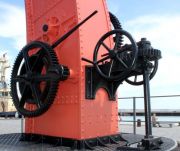Fairbairn Crane


















This entry refers to the type of crane patented in 1850 by William Fairbairn. The patent expired in 1875.
The crane's distinctive feature was a curved wrought iron box girder jib.
They were made by a number of firms in the UK and abroad, including Caillard Frères of Le Havre.
The Wikipedia entry provides good information on these cranes.
Richard Byrom identifies 80 known examples of Fairbairn-type cranes from various manufacturers[1]. Surviving examples are referred to below.
1857 'CRANE FOR SALE.— A very excellent 10-ton Tubular CRANE, made about three years ago by W. Fairbairn & Co., Manchester, now in use. To be seen on application at the Wharf of Price's Patent Candle Co. (Limited), Coburg Dock, Liverpool'[2]
Surviving Examples
Survivors are found at the following locations:-
Bristol Harbour (steam-powered, made by Stothert and Pitt).
Calabar, Nigeria. Made by Bedford Engineering Co
Canal de Castilla, Darsena Valladolid, Spain. Photo here.
Dover (Wellington Dock). Made by the Fairbairn Engineering Co in 1868. Recent bizarre addition of a prop. Photos here.
Frankfurt (Oder). Made by H. Gruson - "Maschinen-Fabrik und Schiffsbauwerkstatt H.Gruson Buckau-Magdeburg". Photo here.
Helsingor (Denmark). Made by William Fairbairn in 1862 (original maker's plate intact).
Koog aan de Zaan (NL)
Langenargen, Baden-Württemberg, at the Bodensee (Lake Constance), Germany. Photo here.
Middelburg (Province of Zeeland, NL). Made in Holland in 1861. Photo here.
Rorschach, at the Bodensee (Lake Constance), Switzerland. Photo here.
Seville (Spain). Originally located on the Muelle de Nueva York along the Canal de Alfonso XIII. Moved 500 metres in 2005 to a plaza at the Puente Alfonso XIII. See photos. Almost certainly made by Fairbairn.
Venice, in the Arsenale. Maker not identified. Converted to electric power at some point.
Vienna, at the Anlegestelle 8 on the Handelskai along the Donau.
Visby, on the isle of Gotland, Sweden. Electric powered. Photo here.
More photos of Fairbairn-type cranes in Flickr Fairbairn Cranes Group here.

